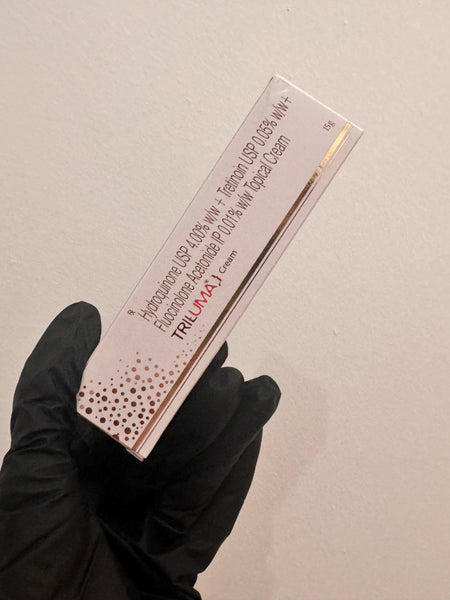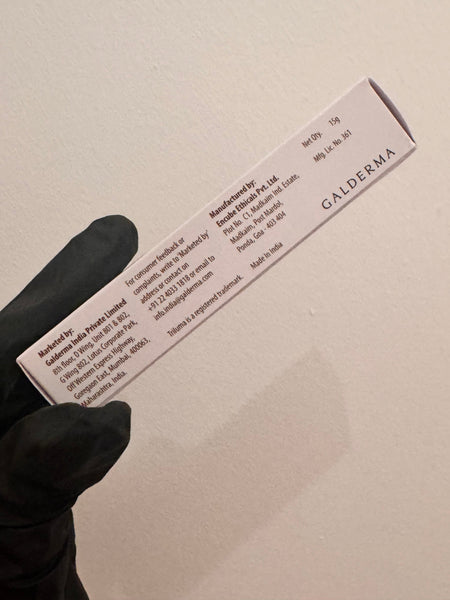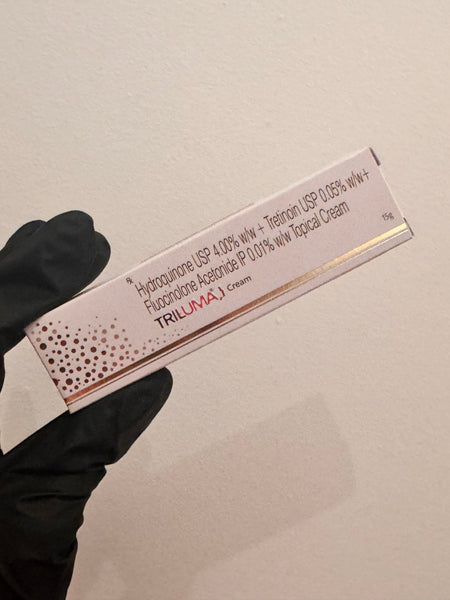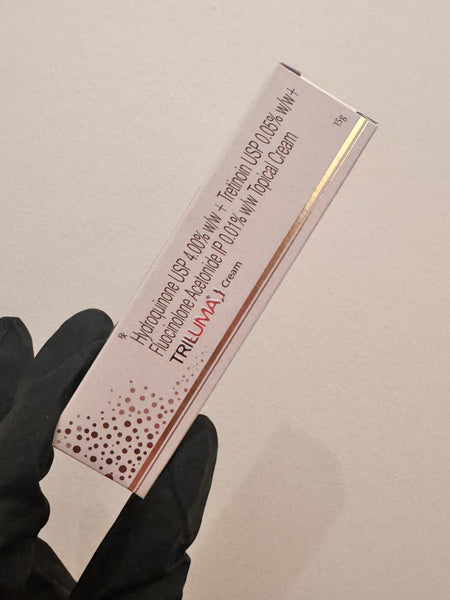UK Based 🇬🇧
100% Payment Secure
WhatsApp Support
Returns accepted for 7 days
EST 2021
Black Friday 10% OFF
Tri-Luma is a prescription topical cream used to treat melasma, a skin condition that causes dark patches, usually on the face. It contains three active ingredients:
1. Fluocinolone acetonide (0.01%) – A corticosteroid that reduces inflammation.
2. Hydroquinone (4%) – A skin-lightening agent that decreases melanin production.
3. Tretinoin (0.05%) – A retinoid that promotes skin cell turnover and helps fade pigmentation.
It is typically used for short-term treatment and should be applied once daily at night under a doctor’s supervision. Common side effects include redness, dryness, and irritation. Long-term use can lead to skin thinning and increased sensitivity to sunlight.
Tri-Luma cream is FDA-approved for the short-term treatment of moderate to severe melasma on the face, with a recommended usage duration of up to 8 weeks. Prolonged use beyond this period is not advised due to potential side effects, including skin thinning and irritation, primarily from its corticosteroid component.
How to Use Tri-Luma Effectively
1. Apply at Night
• Use once daily, at night, about 30 minutes before bedtime.
2. Prep Your Skin
• Wash your face with a gentle cleanser and pat dry (don’t rub).
• Wait at least 20–30 minutes before applying the cream to minimize irritation.
3. Apply a Small Amount
• Use a pea-sized amount for the entire affected area.
• Dab small dots on the skin, then gently rub in a thin layer.
4. Avoid Certain Areas
• Do not apply near the eyes, lips, or nostrils.
• Avoid broken, irritated, or sunburned skin.
5. Use Sunscreen Daily
• Hydroquinone and tretinoin make skin extra sensitive to sunlight.
• Apply broad-spectrum SPF 30+ every morning, even if indoors.
• Wear hats and sunglasses for extra protection.
6. Moisturize to Reduce Irritation
• If your skin gets dry or flaky, use a fragrance-free moisturizer.
• Wait 30–60 minutes after applying Tri-Luma before moisturizing.
7. Limit Use
• It is not for long-term use due to the risk of side effects.
• If melasma persists, consult your doctor for alternative treatments.
Possible Side Effects
• Mild: Redness, dryness, peeling, burning sensation.
• Serious: Skin thinning, excessive irritation, worsening pigmentation (if misused).
Managing Tri-Luma Side Effects
If you experience irritation, redness, or dryness, try these tips:
1. Reduce Frequency
• If daily use is too harsh, apply every other night until your skin adjusts.
• Once tolerated, gradually increase to nightly use.
2. Use a Gentle Cleanser
• Avoid harsh exfoliants, scrubs, or alcohol-based products.
• Look for fragrance-free, hydrating cleansers (e.g., CeraVe, La Roche-Posay).
3. Moisturize Properly
• A light, non-comedogenic moisturizer helps soothe irritation.
• Examples: CeraVe PM, Vanicream, Neutrogena Hydro Boost.
• Apply 30–60 minutes after Tri-Luma to prevent dilution.
4. Apply a Buffer Layer (If Needed)
• If irritation is severe, apply a thin layer of moisturizer first, wait 15–30 minutes, then apply Tri-Luma.
• This slightly reduces its strength but helps with tolerability.
5. Strict Sun Protection
• UV exposure worsens melasma. Use a broad-spectrum SPF 50+ daily.
• Reapply every 2 hours if outdoors.
• Consider mineral sunscreens (e.g., EltaMD, ISDIN, La Roche-Posay Anthelios).
6. Avoid Harsh Products
• No benzoyl peroxide, AHAs/BHAs (glycolic, salicylic acid), or vitamin C initially.
• Once your skin adjusts, you can slowly reintroduce these.
Alternatives to Tri-Luma
If Tri-Luma is too strong or ineffective, consider:
1. Hydroquinone-Free Options
• Azelaic acid (15–20%) – Brightens skin and reduces pigmentation.
• Tranexamic acid (oral or topical) – Helps with stubborn melasma.
2. Other Prescription Creams
• Tretinoin (0.025–0.1%) alone – Increases cell turnover gradually.
3. Professional Treatments
• Chemical Peels (Mandelic, Glycolic, TCA, or Jessner’s Peel) – Accelerates fading.
• Laser Therapy (PicoSure, Q-Switched, LaseMD Ultra) – For resistant melasma (but must be done carefully to avoid worsening).
• Microneedling with Tranexamic Acid – Can help stubborn cases.








